Author: Matt Del Fiacco
Roasted grains are known for producing the chocolate, coffee, and roast characters we love in Stout and Porter. Traditionally, these grains are milled and mashed along with the rest of the grain bill, which not only results in said favorable characteristics, but some believe it also leads to the production of undesirable burnt, acrid, and even astringent notes. In the pursuit of mitigating this trade-off, many brewers have turned to the relatively modern method of cold steeping.
In general, cold steeping involves soaking crushed roasted grains in cool, usually room temperature, water for approximately 24 hours then straining and adding the resultant liquid to boiling wort that was produced without roasted grains. The thinking behind this method stems from the idea that warmer temperatures extract more of these undesirable traits, thus steeping in cool water over a longer period of time allows for the extraction of the good stuff while leaving the bad behind, ultimately making for a smoother and more pleasant roast character. Another purported benefit of this method is that the mash pH is unaffected by the acidic roasted grains, which can make for easier pH management.
As a lover of dark beer, I spend a lot of time brewing styles like Stout and Porter that can include upwards of 12% roasted grains. My process has largely involved mashing all of the grains together, and while I’ve enjoyed the beers I’ve made, I began to wonder if maybe there was a better way. Having never tried cold steeping before, I decided to see how it would compare to my regular process and put it to the test!
| PURPOSE |
To evaluate the differences between a Robust Porter made with roasted grains included in the full mash and one made using the cold steeping method.
| METHODS |
For this xBmt, I went with a tried and true Robust Porter recipe of mine that’s a bit heavier on the roasted grains in order emphasize any effect of the variable.
Cold Feet Porter
Recipe Details
| Batch Size | Boil Time | IBU | SRM | Est. OG | Est. FG | ABV |
|---|---|---|---|---|---|---|
| 5 gal | 60 min | 40.9 IBUs | 36.4 SRM | 1.058 | 1.017 | 5.4 % |
| Actuals | 1.058 | 1.019 | 5.1 % | |||
Fermentables
| Name | Amount | % |
|---|---|---|
| Swaen©Ale | 10.625 lbs | 86.73 |
| Crystal, Medium (Simpsons) | 10 oz | 5.1 |
| Black (Patent) Malt | 8 oz | 4.08 |
| Pale Chocolate Malt | 8 oz | 4.08 |
Hops
| Name | Amount | Time | Use | Form | Alpha % |
|---|---|---|---|---|---|
| Magnum | 19.8 g | 60 min | Boil | Pellet | 12 |
| Cascade | 29 g | 15 min | Boil | Pellet | 5.5 |
Yeast
| Name | Lab | Attenuation | Temperature |
|---|---|---|---|
| Super Special (Ü) | Bootleg Biology | 74% | 60°F - 72°F |
Notes
| Water Profile: Ca 50 | Mg 5 | Na 8 | SO4 36 | Cl 80 |
Download
| Download this recipe's BeerXML file |
I built up a single large starter of a secret strain sent to me by Bootleg Biology a couple days beforehand.
A day before brewing, I crushed the roasted grains for one batch and added them to room temperature water at a ratio of 1 lb per 2 qts of water (0.5 kg per 2 L water)
The following day, I measured out each batch’s full volume of water then began heating them to strike temperature, staggering the start of each by about 15 minutes.
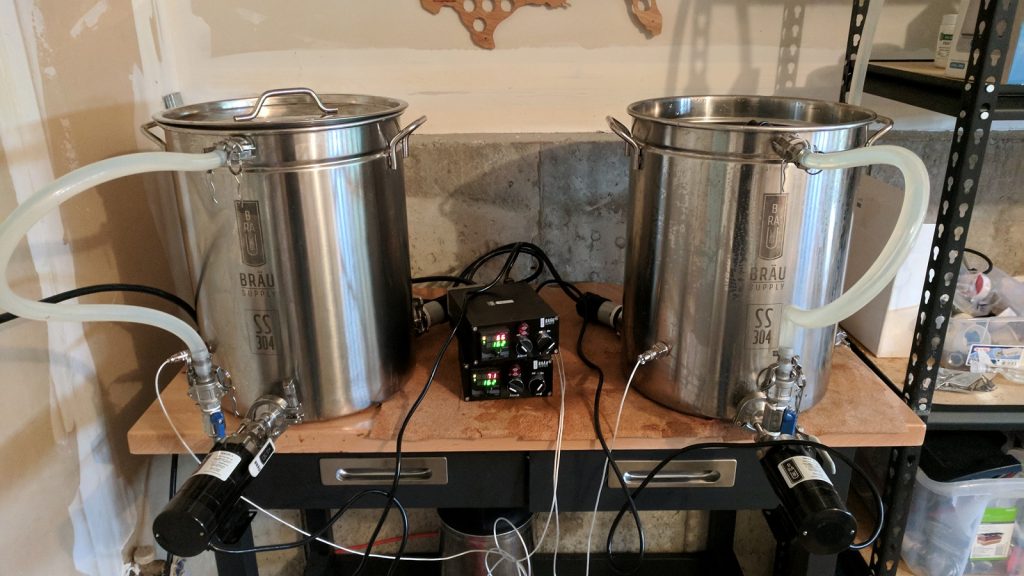
While the strike water was heating, I weighed out and milled the remaining grains for the cold steep batch as well as the entire grain bill for the full mash batch.
Once strike temperature was reached on each batch, I mashed and gave a gently stir to fully incorporate the grains into the water before making sure I’d hit my target mash temperature.
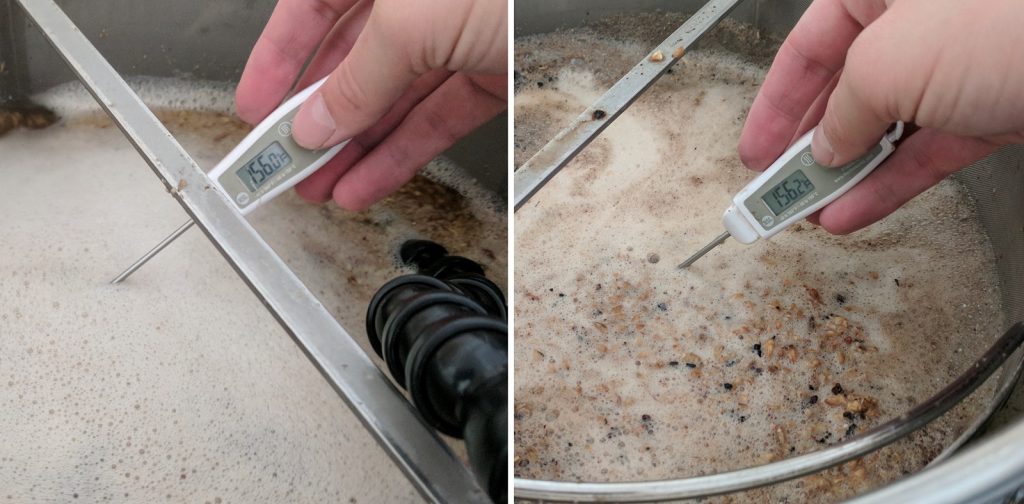
Lids were placed on the kettles and I set the pumps to recirculate. It didn’t take long for the color difference in the mashes to become obvious through the tubing.
I took a pH reading about 15 minutes into the mash that confirmed my assumption– with both volumes of water treated equally, the mash including the roasted malts had a lower pH than the one where the roasted malts were left out.
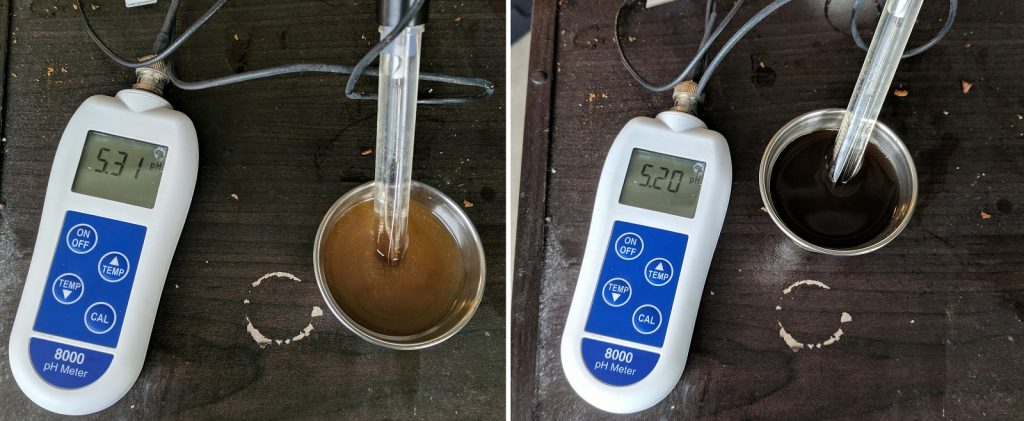
When each 60 minute mash was complete, I removed the grains and set my controllers to boil mode before measuring out the kettle hop additions.
The worts were boiled for 60 minutes with hops added as stated in the recipe.
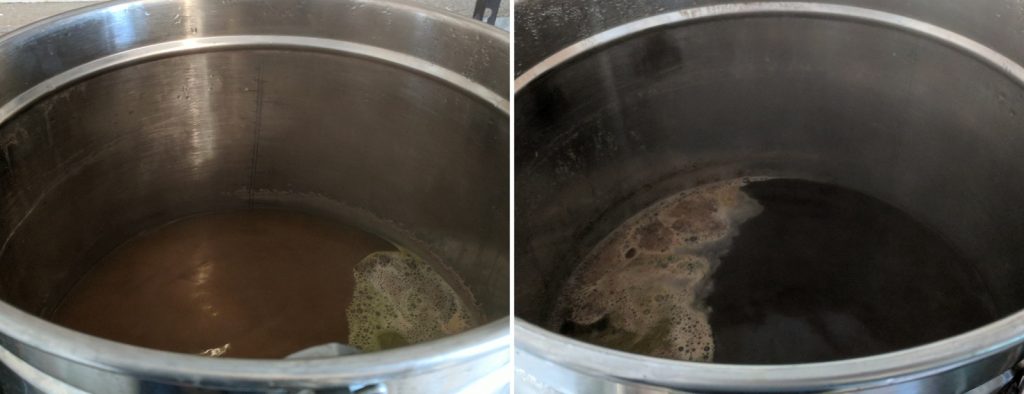
With about 15 minutes left in the boil, I pulled a couple samples just for a color comparison.
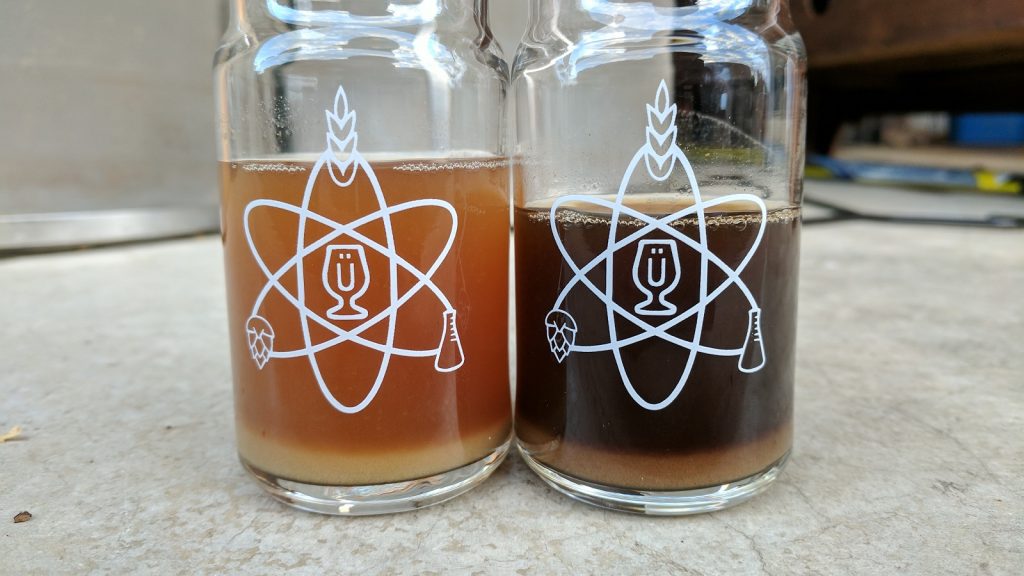
I added the cold steep wort to the boil 5 minutes later, pouring it through a stainless steel hop sleeve to filter out the grains. The color difference at this point was much less stark.
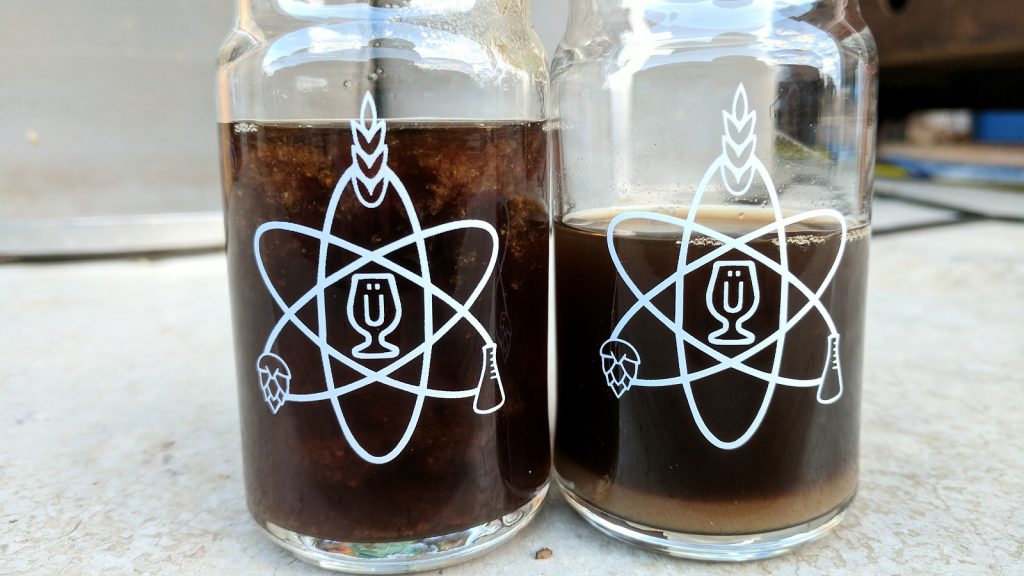
Once the boil was finished, I ran each batch through my CFC directly into fermentation kegs.
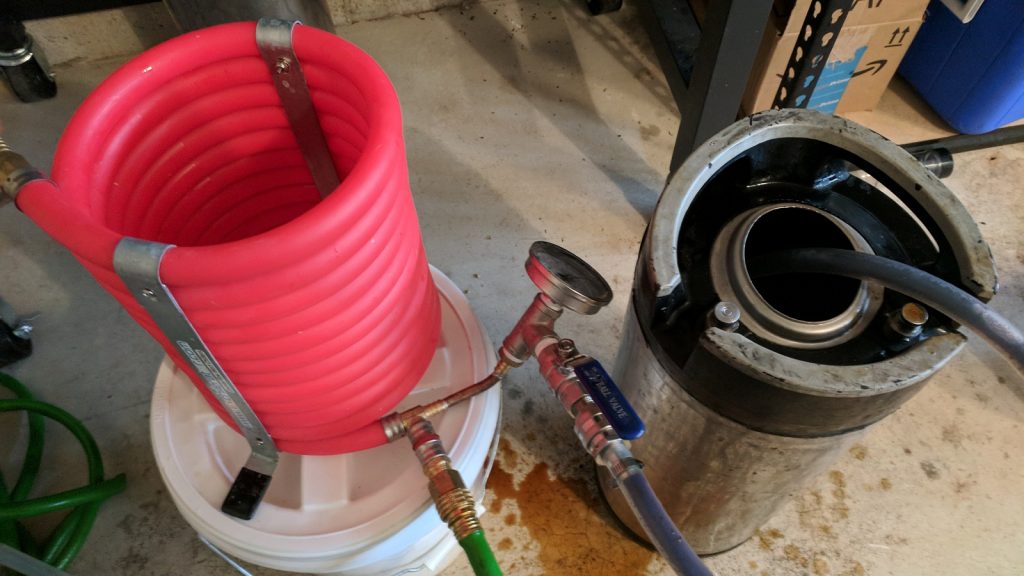
Hydrometer measurements confirmed both worts were at the same 1.058 OG.
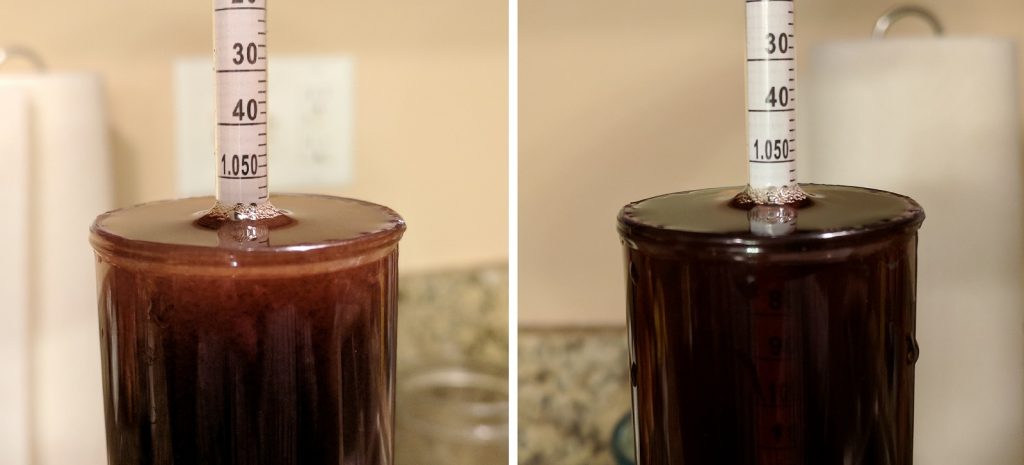
The fermentors were placed in my fermentation chamber and left alone for a few hours to finish cooling. Once at my desired fermentation temperature of 64°F/18°C, I evenly split a starter between the batches. With signs of activity absent after 10 days, I took hydrometer measurements indicating both beers had reached a similar FG.
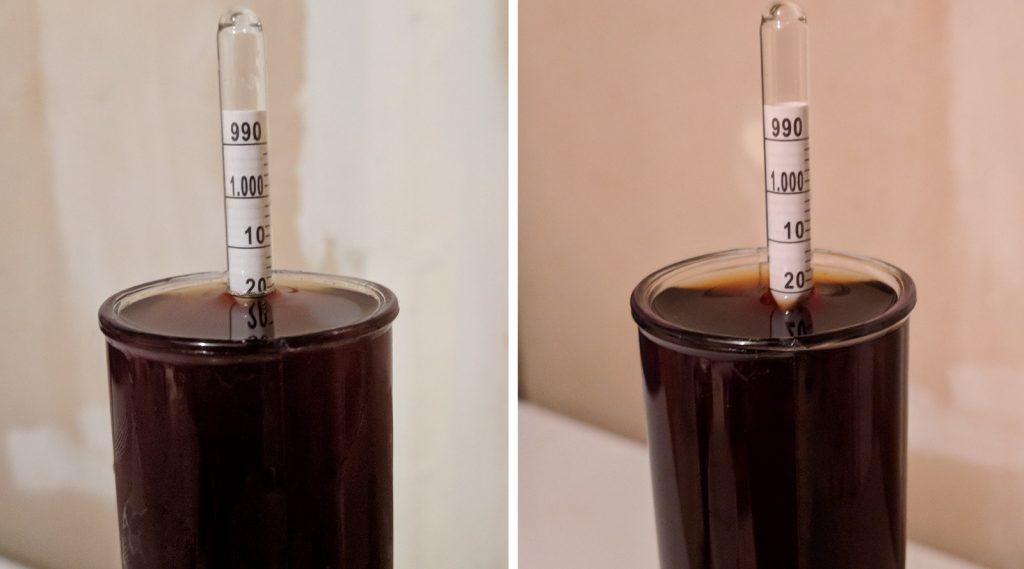
I proceeded to pressure transfer each beer to a fresh serving keg.
The filled kegs were cold crashed overnight in my keezer then fined with gelatin and burst carbonated. After a few more days of conditioning, the beers were clear, carbonated, and remarkably similar in appearance.
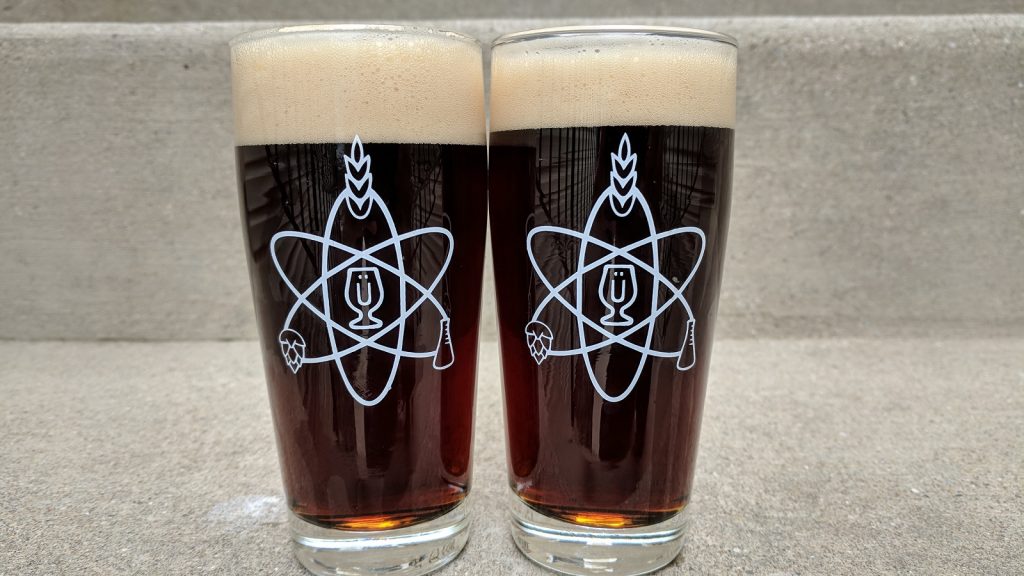
| RESULTS |
A total of 23 people of varying levels of experience participated in this xBmt. Each participant was served 2 samples of the cold steep beer and 1 sample of the full mash beer then asked to identify the sample that was unique. While 12 tasters (p<0.05) would have had to accurately identify the unique sample in order to reach statistical significance, 13 (p=0.02) were capable of doing so, indicating participants in this xBmt were able to reliably distinguish a Robust Porter made with cold steeped roasted grains from one where the roasted grains were included in the mash.
The 13 participants who made the accurate selection on the triangle test were instructed to complete a brief preference survey comparing only the 2 beers that were different. A total of 5 reported preferring the cold steep beer, 4 liked the full mash beer more, and 4 reported having no preference despite noticing a difference.
My Impressions: I was pretty unsure of what to expect from these beers when triangle testing myself and found I was able to pick the odd sample out 4 out of my 5 attempts. I perceived the cold steep Porter to be fairly inline with my expectations, the overall roast character was restrained and less harsh, which I believe consequently led to it being a bit more caramel forward than the beer made with the roasted malts included in the mash. I also detected more hop flavor in the cold steep, which helped in my triangle test performance. Overall, while I really enjoyed both beers, my preference was for the cold steep example.
| DISCUSSION |
One of the more common complaints from brewers of dark beers is that they end up being more ashy and astringent than desired, which some have chalked up to the type of roasted grain used or even water chemistry. However, understanding that temperature and time affect grain extraction, some brewers cleverly began cold steeping their roasted grains to help mitigate the issue, a practice supported by the fact tasters in this xBmt were able to reliably distinguish a Robust Porter made using the cold steep method from one where the grains were included in the mash.
Despite accepting that preference is largely subjective, I found it interesting that both the cold steep and full mash beers won the favor an equal number of tasters who were correct on the triangle test. While the cold steep sample better fit my mental idea of a Porter, participants weren’t necessarily aware of the style and hence were left to choose a favorite based entirely on their sensory experience. There’s really no good way of knowing, but I am curious about these tasters’ general preferences for Stout and Porter.
A common recommendation when it comes to cold steeping is to increase the amount of roasted grains used by as much as 3x in order to provide a similar strength of flavor as a full mash without the undesirable characteristics. My experience with the beers in this xBmt certainly supports the notion that, cold steeped roasted grains provides less overall character than when the grains are included in the mash, all other things being equal.
I’ll absolutely utilize the cold steep method again, but only in specific contexts. I’ll skip it when making styles like Russian Imperial Stout and Dry Stout where I actually prefer some of the characteristics that come from roasted malts being included in the mash; however, I think it’s a great option for styles like Oatmeal Stout and Porter, which I prefer to have a smoother roasted character.
If you have thoughts about this xBmt, please feel free to share in the comments section below!
Support Brülosophy In Style!
All designs are available in various colors and sizes on Amazon!
Follow Brülosophy on:
FACEBOOK | TWITTER | INSTAGRAM
If you enjoy this stuff and feel compelled to support Brulosophy.com, please check out the Support Us page for details on how you can very easily do so. Thanks!

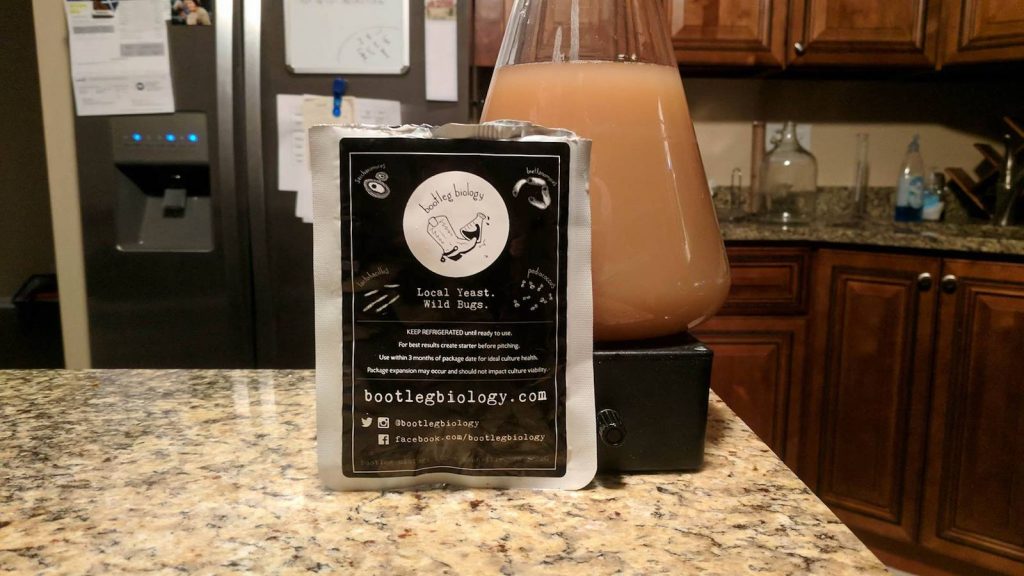
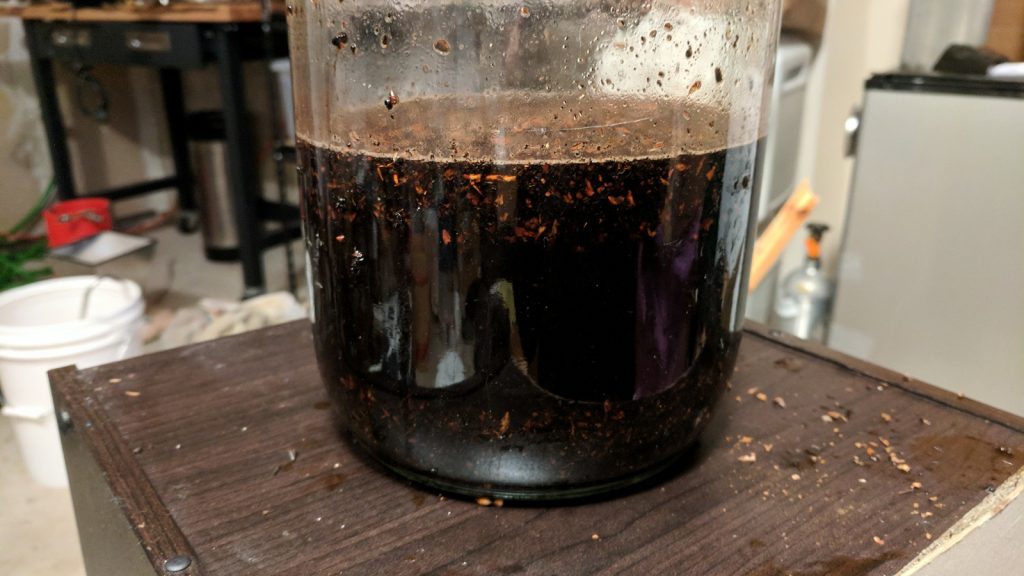
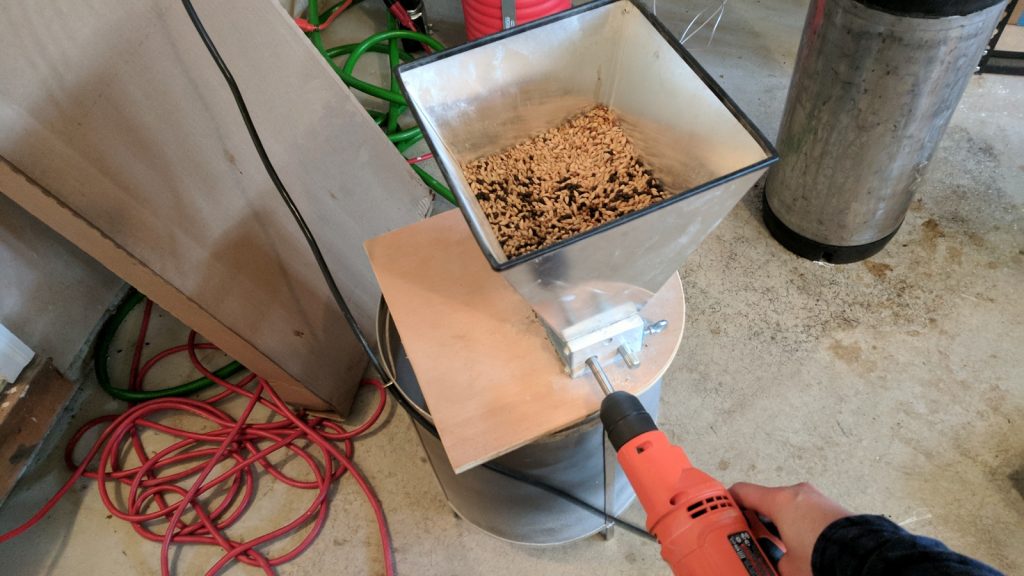
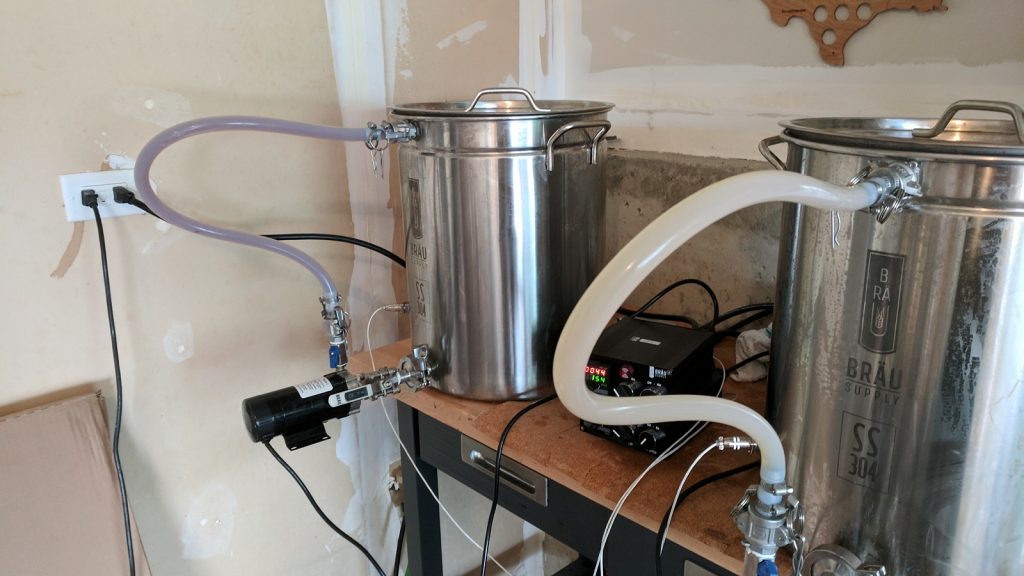
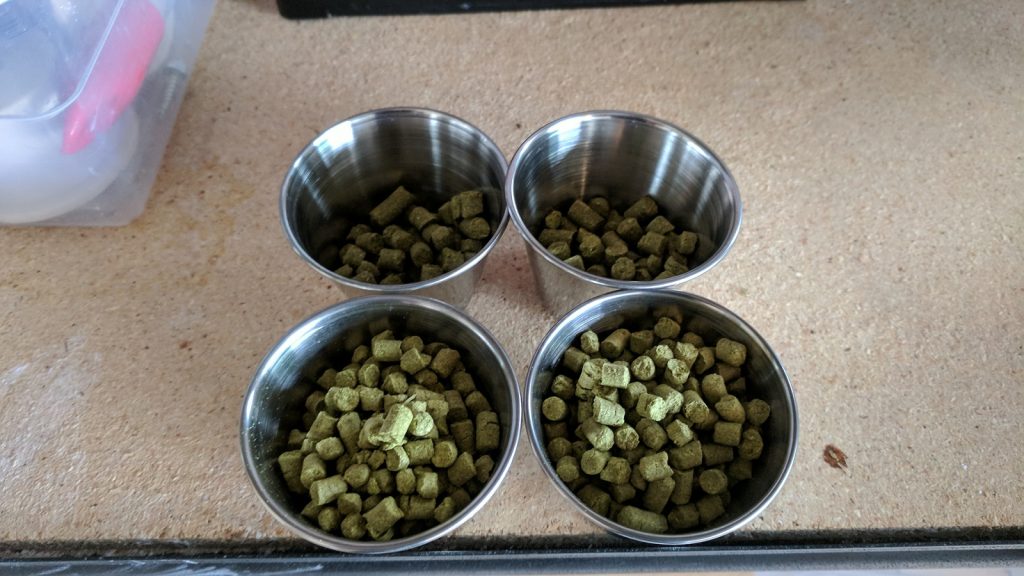
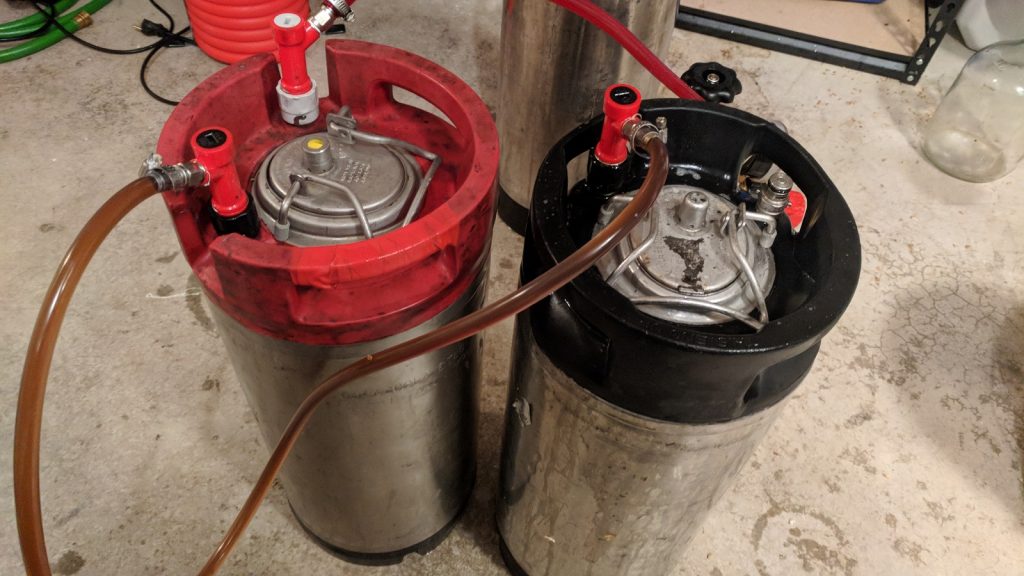










54 thoughts on “exBEERiment | Roasted Grains: Cold Steeping vs. Full Mash In An American Porter”
Great read! I haven’t messed around with cold steeping dark grains much either, but now I may be giving it a shot to see how much smoother I can make my caramel vanilla porter 🙂
It’s definitely worth experimenting with! Let us know how it goes, this xbmt has really energized me to think more about how we are adding different ingredients.
Due to the sugars not being converted when they are cold steeped vs being in the mash tun, do we assume that the cold steeped grains are simply for color and flavor, but not fermentability? I see that you ended up with the same OG on both beers. Did you compensate with more of the other grains in the mashtun with the coldsteep batch to match the OG of the batch that put the roasted grains in the mashtun?
You really aren’t getting any fermentables with roasted malts either way. Whether you mash or cold-steep, their only contribution is color/flavor.
Roasted malts certainly do contribute to the final extract yield!
http://howtobrew.com/book/section-2/what-is-malted-grain/table-of-typical-malt-yields
You can extract the sugars resident in the malt – created during the steep/kiln/ roast process – but they do not typically require conversion via enzymes as they are hopefully not starches.
I think what people were surprised by is that the OG is the same for both batches. The roasted malts will contribute to that OG and the quantity of whatever is being extracted from the roasted malt doesn’t seem to be temperature dependent nor is its fermentability (as evidenced by the fact that the FGs are the same). I would have been curious about the pH and gravity readings of the cold extract over time maybe even with some optical densities tossed in.
Heavily roasted grain (such as chocolate, black patent…) does not have diastatic power so there is no sugar to convert. This is what makes cold steeping a possibility.
Hope this helps.
The diastatic power of a malt has nothing to do with the starch content of a malt. A roasted malt in a mash will still contribute polysaccharides which can be broken down by enzymes in the mash.
But if it’s mixed with base grain that makes it possible to convert sugars because base has enough diastatic power. When you cold steep you don’t have this effect. But I think it doesn’t matter much since the amount of roasted grains is relatively low and most of it is not convertable.
I just finished cold steeping 2lb dark grains for about 18 hours. My refractometor said 1.030. I decanted the wort and replaced the water. The refractometer read 1.018 about 6 hours later. I think (no exbeeriment) decent and replace gives me more of the extract from the dark malts.
I don’t believe there is any way all of this could be considered non fermentable. I add this wort to the soaking base grains before I take a 20 min pH and adjust as needed. The first cold steep liquor had a pH of 4.6. Didn’t check the second.
I count the decanted volume as part of the water needed for the biab total mash water needed.
Highly Roasted grains do not contribute any fermentables to the mash. They are strictly for color and flavor.
Thanks for another great xbeeriment! It leaves me curious to compare a cold steeped beer made with 2x or 3x the dark grains to one made with normal dark grain quantity added in the mash. That might highlight the unique benefit of cold steeping, or else show that its effect can be approximated by simply reducing dark grain quantity in a mash. Or am I missing something else?
I m asking myself the same question, may be there is a temperature for which a good compromise can be foun between quantity multiplications (use efficeny of dark grains) and low harsh… i mash datk grains at 60-64°C for less than 1 h and its fine but theres the problem with the body: that mash will lower FG (and thats how i explain the 1 pt difference in FG, in this wonderful and clear Xbmt) as alfa alimase activity has not been at its best in that part …also with cold brew, that “wort” has coulor but it thoes’nt have body…
I bet the effect would be even more noticeable in a style like Schwarzbier or black IPA.
Definitely worth trying, I love Black IPA. I think it’s just because of Nostalgia for Stone’s Self-Righteous.
Planned on Brewing a schwarzbier tomorrow. I wonder if mashing the dark grains separately then adding that wort to the end of the boil would have a different (ideally beneficial) result or would be substantially more work producing minimal improvement?
I do something similar to this for my black ipa, resulting in a noticeable desirable difference.
Instead of cold steep I simply hold back the dark grains from the mash (sub. with extra equal weight of base malt to the mash), and add at the beginning of sparge.
Resulting effect produces a lighter drinking more crushable beer still posessing the color/roast/flavor of the dark malts without the body/bitterness/astringency. Mash on the lower end too 148-150F.
I would be interested to see an Xbmt comparing cold steeping vs. sparge addition on roasted grains.
Thank you for another Xbmt! Usually I proceed the same way Chris does. I also add the grains add the end of the mash/beginning of sparge. If I am not mistaken Gordon Strong reccomended this in his last book.
It would be really interesting to see an Xbmt comparing cold steeping vs. sparge addition on roasted graines.
Thanks again for this great Xbmt! Cheers
The author did a later exBeeriment with full mash vs hot steep – not quite the same as doing it with the sparge/vorlauf, but close: https://brulosophy.com/2020/11/02/roasted-grains-full-mash-vs-steeped-in-a-robust-porter-exbeeriment-results/
At the end of the article it was mentioned that sometimes as much as 3x as much roasted grains is used to compensate for cold steeping. This would impact effeciency and also be more expensive. Has anyone tried to split the difference between a full temp and cold steep? Perhaps a “sous vide mash?”
Cool! I’ve read about cold steeping, but have been wondering how it stacks up in comparison. Now I know! Might try it for a future batch. I’ve experimented some with adding dark grains during the vorlauf, but haven’t done a head-to-head on that technique; I’d be curious to see how that stacks up vs. cold steeping or full mash duration.
It’s on the list! Any excuse to make a stout/porter.
Thank you for another well-thought-out experiment! I have tried Gordon Strong’s procedure where the dark grains are added to the mash at the vorlauf. I brewed my favorite stout recipe back-to-back using both procedures. The first few months I preferred the batch where the dark grains were mashed(not surprising, I love my coffee strong and black). But after aging for six months, I found that I much preferred the batch where the grains were added at the vorlauf. Perhaps my tastes just changed. Might be worth your while to bottle some from both batches and run your experiment again in a few months. Thanks for what you do!!
Love the idea! I think there’s a lot of potential there, and we definitely plan to keep playing with these variables.
I’ve followed Strong’s Vorlauf practice too after reading his books. I have never cold-steeped. Is there much of a flavor difference in Vorlaufing the dark grains versus cold-steeping?
Great write up.
I have used this method when I want tartness from the fermentation but minimal roast, and found that, just as you pointed out, the crystal malt profile shines much more than it normally would.
Interesting experiment and something I am definitely going to try on my next beer. What would be an interesting follow-up Exbeeriment is comparing a cold steeped roasted malt batch vs a mash capped roasted malt batch, i.e. Gordon Strong’s method of adding roasted malts at vorlauf.
“I went with a tried and true Robust Porter recipe of mine that’s a bit heavier on the roasted grains in order emphasize any effect of the variable”
You said you do dark beers that are up to 12% roasted grains and then did a recipe for this test with 8% roasted …. not sure I’m following your recipe formulation logic here. I wouldn’t consider 8% roasted malt to be a heavy robust porter.
12% is where my RIS floats, which is in line with many of my preferred commercial examples (usually 7% chocolate, 5% RB).
The intention wasn’t to make a “heavy” robust porter as per the typical style, which 8% would be in line with the average amount of roasted malts used in the style from a few commercial examples and past NHC recipes. The “heavy” is regarding the 8% in the context of my usual Robust Porter recipe, which usually sits at 5% roasted malts. (3% Black Patent, 2% Pale Chocolate).
I’ll definitely try that in my black lager ! Thanks, that’s why I love you so much guys!!!
Why didn’t you use the liquid from the cold soak as your mash liquor for the base malt? Or add it directly to the full length boil?
Why would I have?
The typical process for adding cold-steeped liquid is to add it during the boil. I would love to try your suggestion in the future, could be a cool comparison!
If I read it right, you didn’t add the cold steep wort until later in the boil. This could have contributed to color and flavor differences. Interesting experiment though!
Awesome write up. I have been using cold steep grains a lot as it allows for me to have a “main mash” that I split into 2 boil kettles. 1 kettle will receive the dark grains while the other does not. I have mainly been using it to allow for the complexity of brewing multiple beers from the same mash. My results (comparing my “main mash” brewing vs regular mashing) have been the same as you found although I have not done the side by side comparison as you have. It is good to know how it compares with such a direct comparison. Cheers!
It’s also good for dark lager like a Schwarzbier.
I used cold steeping recently when I was doing a partigyle brew. My base malts went into the mash. The first runnings went into the brew kettle for the boil with the cold steeped dark malt liquor added at the end of the boil. The second runnings went for a pale ale.
I’ve always steeped my dark malts for only 20 minutes, compared to 1 hour for the rest of the mash bill.
Great experiment! Would you recommend increasing the amount of dark grain for steeping by 2-3x as you mentioned in your discussion? If I’m not mistaken, it looks like you had similar colour in both beers using equivalent weights of dark grain.
Great read! I’ve steeped roasted grains in the past and definitely tasted the difference. I would love to see steeped roasted grains vs. Carafa Special I, II or III experiment to see if a difference can be noticed. Thanks!
Looks a bit light in color for a “robust porter”, but maybe it’s the size of the glasses.
Jamil’s take (the Brewing Network) on cold-steeping is that you get less extraction; therefore, lighter color, less roast. But the two look very similar to me from the picture.
In Mitch Steele’s IPA book, one of his Black IPA recipes uses the technique–I think it’s his tribute to Deschutes’ “Hop in the Dark”.
Awesome read! I’m actually brewing an Oatmeal stout this weekend and was considering cold steeping my roasted grains to try something new!
I can attest to the results of Cold Steeping Dark Grains – winning a homebrewcomp with a farmhouse imperial sout it the epitomy. and I know that a kilo of roasted grains in the mash would’ve created something considerably harsher, and less smooth.
being a farmhouse styl,e and given the roasted cold steeping the FG finished a few points lowerthan expected (not surprising).
I used a small portion of the dark grains for PH only (here its around 200grams of chocolate malt) to bring into line with around 5.4ph. the cold steep is then done overnight and added to the boil with 10 minutes remaining.
……………………..speaking of which im running out of said ber, time to rebrew i think…..
Great piece here. Not at all surprised that results came out significant. I have done the cold steep many times on my dark beers and I’m sold on it. One point I’ve noted is that the 1:1 comparison may not be the best as I find that the dark malts in cold steep don’t impart the same intensity and a 1:1.5 or 1.5x increase w cold steep gives a roastier flavor without the astringency, particularly in stouts.
I would like to see an Xbmt comparing cold steep vs. vorlauf/sparge addition of roasted grains!
A good “compromise” that I recommend everyone look into is to steep your chocolate/dark roasted grains for only 15 minutes. this has helped me avoid that burnt flavor some brewers seem to love.
Great article, just wondering though: when adding the cold steeped grain liquid at the end of the boil you’re adding essentially un-fermentable tea to the batch which is diluting it. So should we subtract the amount of cold steeped liquid we are adding from the starting boil level? I hope that makes sense, maybe I’m just not understanding it correctly but it seems like that would be the way to go to get the correct OG. For example if I am brewing a 5 gallon batch and am adding 3.5 quarts of cold steeped liquid at the end of the boil, I should probably start the boil with 3.5 quarts less than if I was just boiling a full batch. Hope that makes sense, any help is much appreciated!
An easier approach. A room temperature (cold) steep will leave behind some of the compounds which cause the harsh flavors. Once lautering of the steep is complete the wort is safe for boiling, since the harshness is left in the spent roasted grains. Hop efficiency changes with wort concentration, therefore to keep brewing software IBU results accurate, add the cold steep to the kettle with the mash run off. Adding cold wort with 10 minutes left is a delay also effecting the IBU’s.
It would be really interesting to have a comparison full mash compared to specialty/dark grains included in the last 15-20 minutes of the mash that a lot of folks here in Australia are now doing. Great xBEERiment once again, such an interesting site, beerbusters lol.
Or perhaps a 2h lets say 40°C mash….
Quite a few really misleading comments should be deleted, I think.
Roasted malts have sugars in them, as the roasting converts starches to sugars. This conversion can result in more not fermentable sugars as the temperature and time increases, hence the yields of higher °L/EBC/SRM malts decrease. The crystal malt in this recipe has 85% of starches crystallised or in other words, 85% is converted to sugars already – the darker grains have way over 90% of starches converted to sugars in them. You do not need enzymes as you don’t really have starches, hence cold steeping can extract the sugars and that is why the two batches started from a similar OG.
Since you recommend using 3x the amount of roasted grains for cold steeping, did you use 8oz of one roasted grain for mash and 24 oz of the same grain for the cold steep?
Would adding coffee in with the cold steeped grains be a good option for making a coffee stout?
Great exbeeriment! I’ll be trying something similar myself soon.